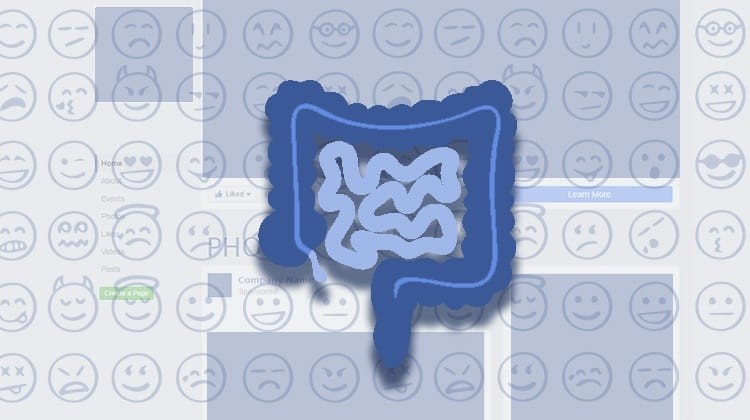So, if you’ll manage to get a person excited in your Facebook ad offer, they’re a lot more likely to make the purchase based on the momentum! For example, VASA Fitness made some obvious choices when making this Facebook ad to create feelings of excitement.
Go For the Gut! How to Use Emotional Marketing with Facebook Ads
by Cydney Hatch • February 22, 2019
Did you know it takes less than three seconds to have a gut reaction?
In fact, Dan Hill in Emotionomics said, “Emotions process sensory input in only one-fifth the time our conscious cognitive brain takes to assimilate that same input.”
Emotions have a profound impact on our decisions, create lasting first impressions, and actually inspire us to follow the same pattern of action in the future.
So, what does this dangerous piece of marketing information mean for today’s marketer?
GO FOR THE GUT!
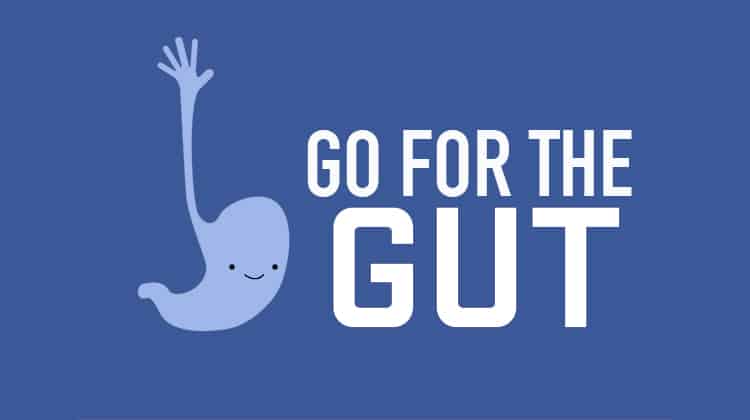
In today’s world, where people are bombarded with ads everywhere they go, the best way to ensure your business/brand stands out amongst the rest is to implement emotional marketing and go straight for their emotions!
Done right, emotional marketing differentiates and helps businesses stay competitive amongst the ever-changing environment of the internet. Well-executed emotional marketing will have a lasting effect on a brand’s potential customers.
So, if you want to learn how to use emotional marketing on Facebook, this is the article for you! Let’s get the tissue boxes, boxing gloves, and ugly crying faces ready! Emotions-are-a-coming!
What is Emotional Marketing and Why Do You Care?
Simply put, people feel. It’s in our human nature…
All humans feel four basic emotions: happy, sad, afraid/surprised, and angry/disgusted. While you typically do not want your potential customers feeling repulsed when they see your marketing content, creating strong emotions—either positive or negative—can help build a bond between your customers and your business like nothing else can.
In fact, out of 1,400 successful advertising campaigns, those with purely emotional content performed about twice as well (31% vs. 16%) as those with only rational content.
This is what emotional marketing is all about: content that evokes emotion within potential customers. It is manipulating their feelings and stimulating their emotional triggers towards buying or intended actions.
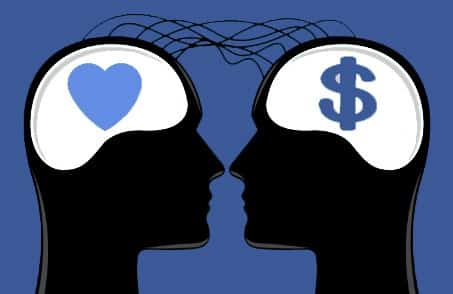
Today’s consumers have limitless information at their fingertips and are thinking along the lines of their own needs, priorities, and feelings when shopping, so as a business you need to get in touch with your sensitive side and learn what your customer needs to feel in order to take action.
Emotional marketing—especially on social platforms like Facebook—benefits your business in that it helps you:
- Make Great First Impressions
- Inspire People to Connect With Your Brand Message
- Move People to Act With Their Hearts
- Inspire People to Take an Intended Action
If getting in touch with your feelings makes you feel like you are in “a glass case of emotion” or it does not come naturally, that is okay! In the next section, we will share emotional marketing elements you can use in your Facebook campaigns as well as across your other social media platforms!
Emotional Marketing Strategies to Use on Facebook
Wondering how you can apply emotional marketing to Facebook Ads and beyond? Using the elements below, you can successfully tap into the hearts, minds and guts of your potential clients!
Know What Gets to Them
Like anything worthwhile in marketing, you need to do your homework before you can “ace” the assignment.
If you don’t know your audience, how will you know what kind of content they’ll respond to best? How will you know which emotion gets to the heart and soul of what you want your audience to experience?
Before you start playing with emotions and deciding which ones to work into your marketing content, conduct some target audience research.
One of the best ways to answer the above questions is to hold surveys and polls via social media, one on one interviews or focus groups. Services like SurveyMonkey are very useful to share out polls and surveys across many platforms and they also offer suggestions on how to phrase certain questions for valuable and relevant responses.
By taking the time to do this, you will not only resonate with your audience’s pain points and needs, you will also be well equipped to make marketing decisions.
Color Code Emotions
Color Psychology: the study of hues as a determinant of human behavior (yes, it is a real thing).
The psychology of color as it relates to persuasion is one of the most interesting—and most controversial—aspects of marketing. Some people claim it matters, and some people really question its power over people. But since color is an essential part of how we experience the world, we at Disruptive say it matters—especially when it comes to conversion!
Color plays a huge part in our subconscious decision making and a lot of people and brands claim color generalities like:
- Yellow = For Internet “Window-Shoppers”
- Red= For Urgency
- Blue= For Promoting Trust
- Orange= For Calls-to-Action
- Soft nd Soothing Shades= For Ladies
- Bright & Ecstatic Tints = For Guys
- Black = Expensive or Luxury
- Purple= For Calming
- Red, Orange, Black, and Light Blue= For Impulse Buyers
- Dark Blue and Teal =For Sensible Shoppers
- Pink, Rose, and Light Blue=For “Normal” Buyers (in between impulse and budget)
But in our experience, the uniqueness of the color and the contrast of it compared to the rest of your content is what really produces results. Be sure to specifically use colors that help certain call to action or information become apparent in your ads like WordStream did below using dark blue and contrasting orange:
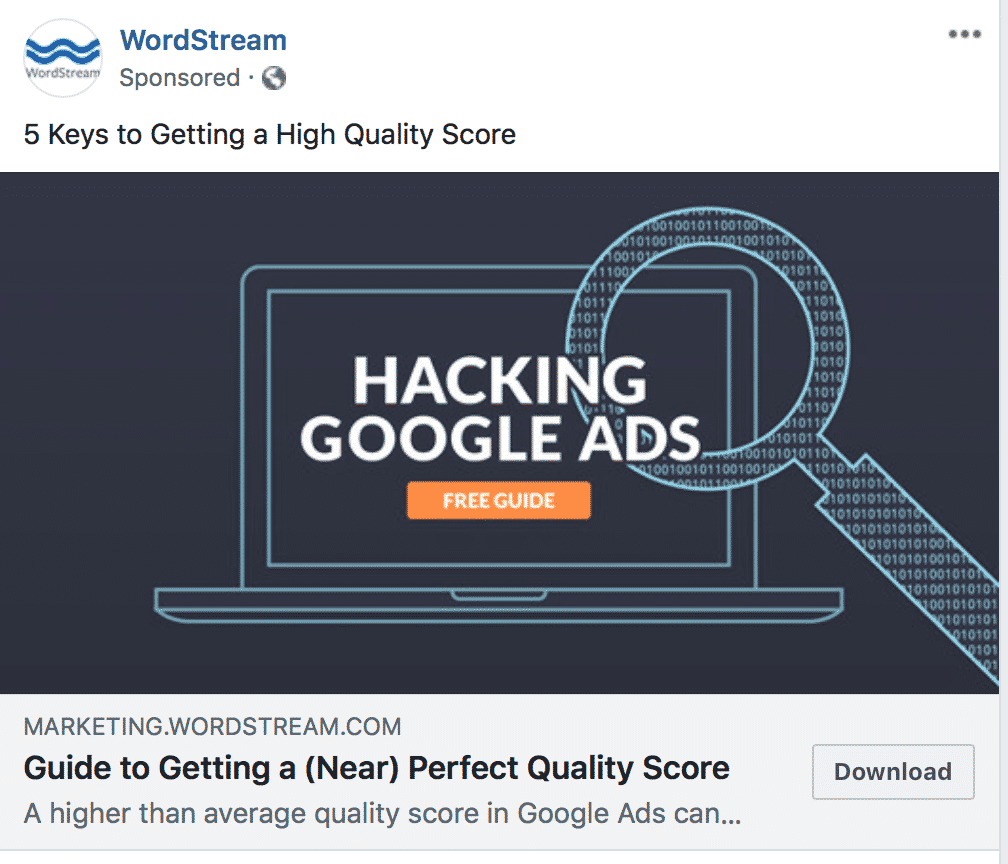
If you want to know what is the best colors to use for your target audience, we say test it. Do not 100% believe the industry norms, your business is unique as are your customers. If you also want a pro tip, Adobe has an amazing color wheel that can help you pick harmonious color palettes from complimentary, monochrome or compound! Check it out here!
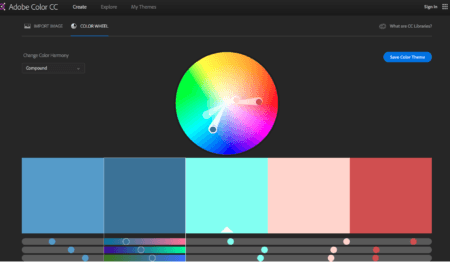
How to Use Color in Facebook Ads:
- Use Branded Colors in Ad Design—Be Consistent
- Do Not Be Afraid to Break Your Color Palette for Contrast Attention
- Negative White Space is Okay
- Avoid Using Shades Close to Facebook Blue
Be a Storyteller
Everyone loves a good story, whether it’s told through song, written word or film.
Social media is a great place where people go to be entertained this way but, if you are a brand advertising on Facebook disrupting potential customer’s entertainment, you might leave customers wanting to skip your advertisement or wishing it down to the depths of marketing hell.
To avoid this, you need to be a brand people are into not one that disrupts what they are into!
Telling stories in social media advertising, particularly on Facebook, is a great way to make your ads feel less like an ad getting in the way and more like part of the entertainment available online.
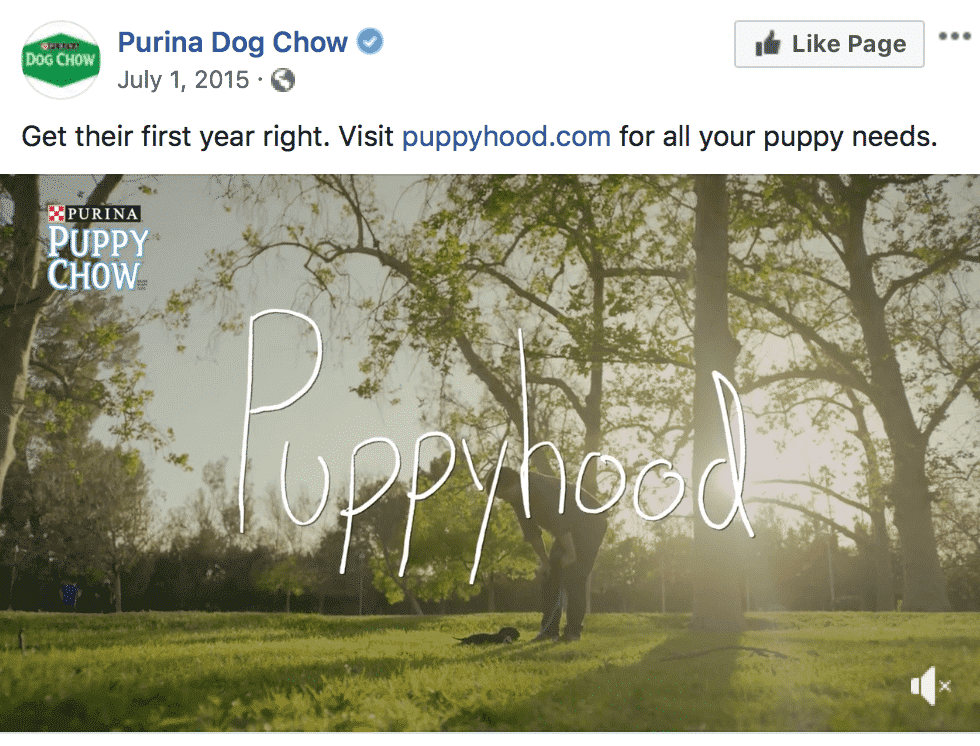 For example, Purina started a cute video campaign that told the story of a man who found a soulmate in a puppy and it’s adorable. This tale of cute companionship has over 10 million YouTube views and segues into Purina’s other content marketing project: a high-level puppy care website that guides consumers through every step of dog ownership.
For example, Purina started a cute video campaign that told the story of a man who found a soulmate in a puppy and it’s adorable. This tale of cute companionship has over 10 million YouTube views and segues into Purina’s other content marketing project: a high-level puppy care website that guides consumers through every step of dog ownership.
As a consumer who saw this during a video ad pause, I was not bothered as it barely felt like an ad at all! The storytelling was craftily created to take away negative feelings of “one more ad” and made an engaging cute story that highlighted the life of a new dog owner.

Another great example is Purple Matress’s simple storytelling in their advertisement of Jared and the Egg. Like these example, you too can create storytelling ads that entertain customers into being delighted by your ads and products not annoyed.
How to Use Storytelling in Facebook Ads:
- Use Common Story Formulas and Simplify Them Down
- Use Carousel Ads to Create a Visual Narrative
- Include Emotions that Customers Will Relate To
- Offer Information Readers Need to Know but Leave Out Details to Pique Their Interest
- Create Strong Verbal Hooks
Inspire Change or Movement
People want to make a difference in the world and many want to feel apart of a cause or community making that difference.
Whether that is a religion, social change motion, politics, or family, we all want to belong.
As an advertiser, there is definitely a market to mix social engagement and business in the social atmosphere. For example, in the world of “Me Too” Feminist Apparel carved themselves out as an apparel ecommerce movement on Facebook that “exists in order to assist people in having the difficult, yet necessary, conversations to continue developing a more feminist future and society.”
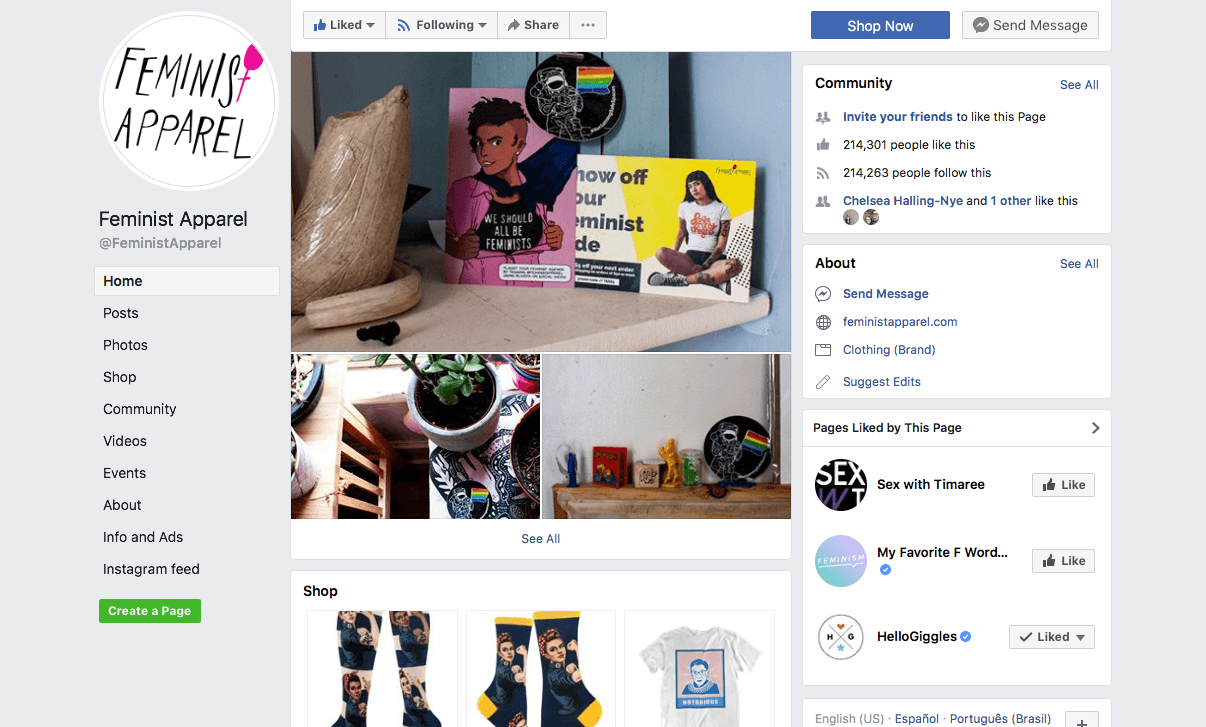
They not only sell socially charged apparel but they use social movements as a way to spread their product recognition and brand mission to improve the world for women. This helps with content creation that is outward facing rather than focusing on their company. They share articles that relate directly to their products as well as other media focusing on female empowerment. This balances content that has sale pitches and asks!
Another example of this is The International Rescue Committee who ran an ad for Valentine’s Day that asks people to donate money to send a girl to school for a year. This Facebook ad not only uses holiday marketing but emotional marketing as a way to inspire people to “give back” and find love beyond the typical paper hearts and chocolate boxes.

So, like these examples, if you create an emotion that equates to “getting a good do-er” sticker, people would love to contribute.
How to Use Community in Facebook Ads:
- Tug at Heartstrings By Aligning Your Business With Social Movements
- Look at Charity Collaborations
- Give Customers Gift for Donating or Being Apart of The Community (Pins, Stickers, T-shirts)
- Share Statistics That Relate Your Products/Business To A Social Movement or Cause
Tap Into “Fear of Missing Out”
No matter how much control you think you have, most people make impulse purchases.
How many times have you been compelled to buy something because there were only so many left? Whether it’s the Kylie lip kits that fly off the shelves or signing up for those dang 5K races with your friends that require you to sign up for early bird dates, we all do not want to miss out!
The concept of “NOW” and receiving a benefit for it is a real thing in marketing and many businesses see great success pairing time with benefits!
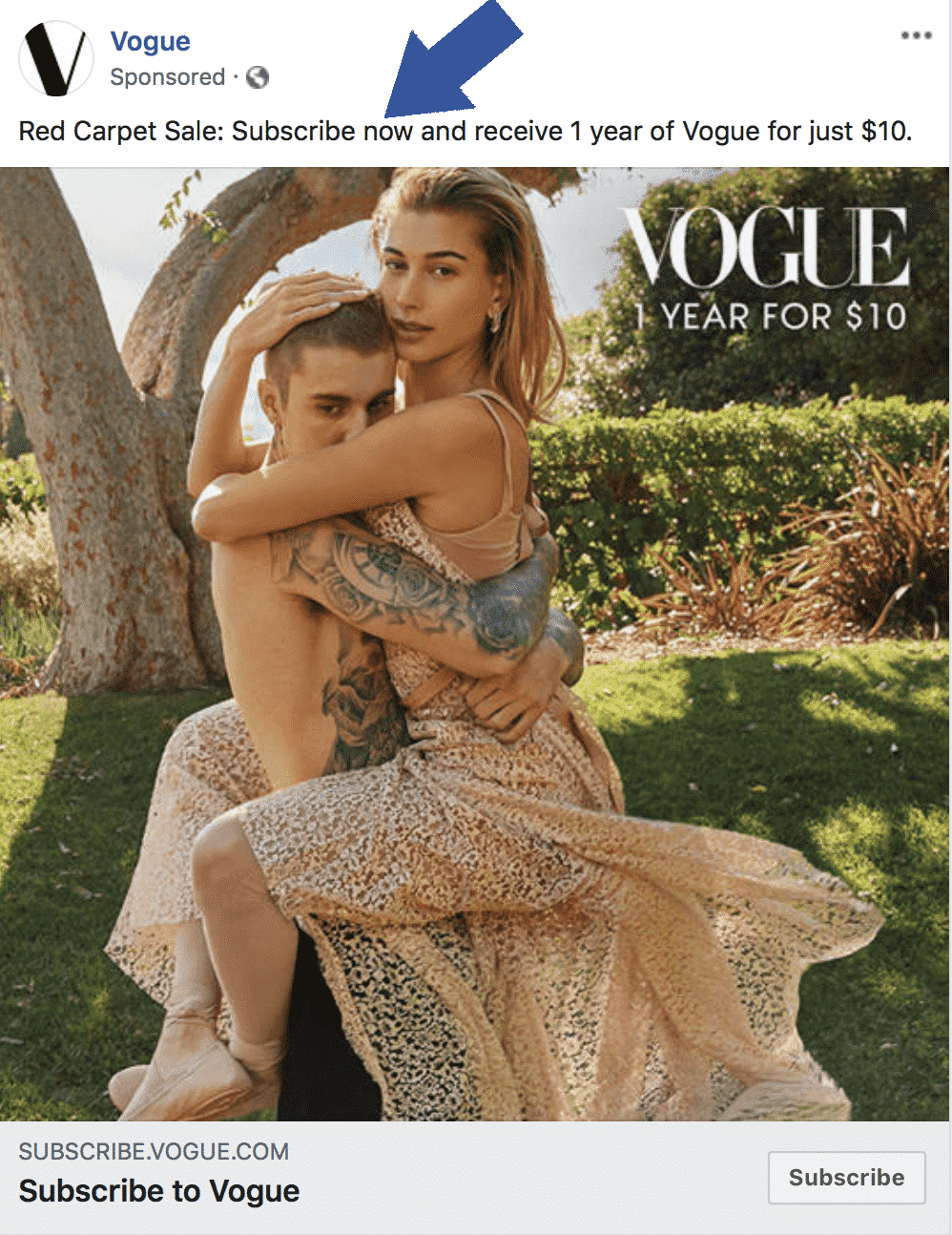
According to psychological research, “the reptilian” brain (the neocortex) expresses itself in people’s obsessive-compulsive tendencies, the flight-or-fight response and the actions people take in response to urgencies. These are precisely the factors that inspire impulse purchases. It is also a simple perception of scarcity!
So, as a business, you can capitalize on the “impulse buy” phenomenon by asking customers to:
- BUY NOW!
- TRY IT NOW!
- SHOW NOW!
- VIEW NOW!
- GET IT NOW!
- SUBSCRIBE TODAY!
Scarcity and feelings of FOMO are strong motivators! Make use of them by offering limited edition items, limited numbered orders or set deadlines!
How to Use “FOMO” in Facebook Ads:
- Mentioning the Number of People Already Benefitting From Your Products/Services
- Craft Buttons with “FOMO” Phrases Like the Ones Mentioned Above
- Posing a Question That Makes Them Feel Left Out of An Opportunity
- Add an Enticing Benefit for the Intended Action
- Making Your Followers Feel Like They Need to Be a Part of Something
- Offering Your Product/Services for a Limited Time to Nudge People
Wear Overalls Again
I don’t know about you, but Osh-Kosh overalls were really big when I was a kid. Fast-forward to 2019, with overalls being back fashion in a big way, I cannot help but feel sweet nostalgia.
Modern marketing has caught on to tapping into this feeling as Millennials respond well to this emotion: fond memories. From fast food to gaming systems, smart business brands are engaging their retro roots in emotions that gain great success with modern consumers. The LA Kings took to Facebook with Nostalgia marketing that invited kids of the 90s to come for a special night of sports and “blast from the pasts” music!
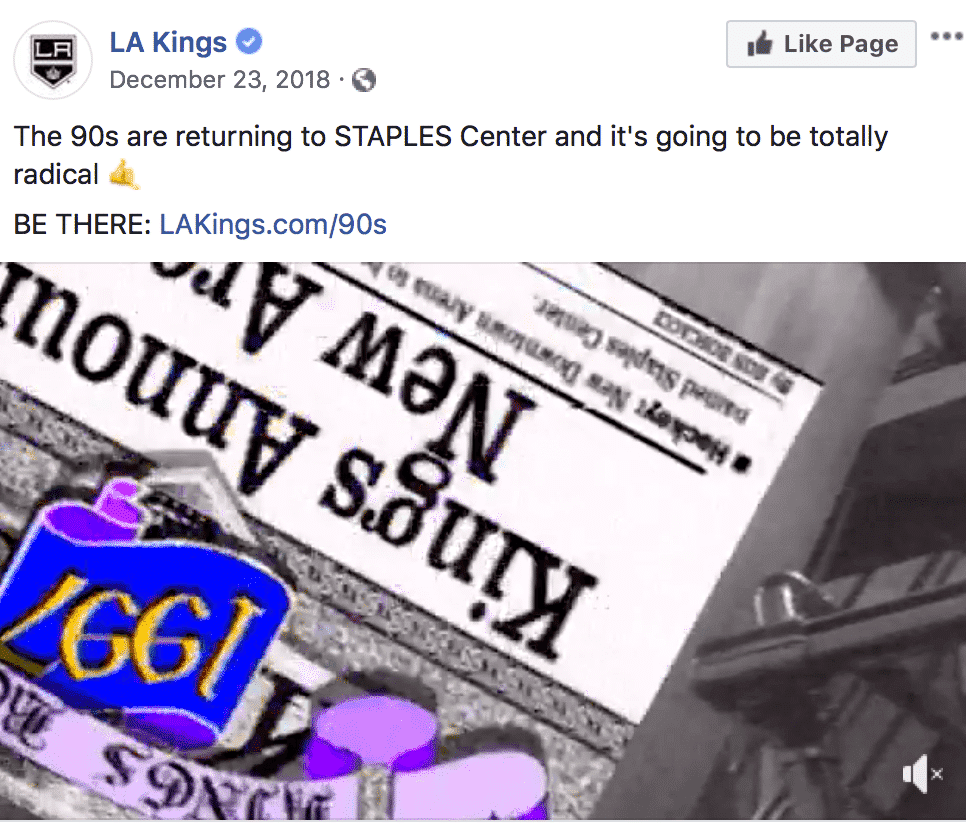 Another example is Microsoft connected with a whole generation of people, the children of the 90s, with a campaign that reintroduced themselves to the people who grew up with the internet. From slap bracelets, ying-yang signs, to showing outdated technology most kids haven’t even heard of, nostalgia is a powerful marketing tool!
Another example is Microsoft connected with a whole generation of people, the children of the 90s, with a campaign that reintroduced themselves to the people who grew up with the internet. From slap bracelets, ying-yang signs, to showing outdated technology most kids haven’t even heard of, nostalgia is a powerful marketing tool!
We, children of the 90s, can connect with the toys, dial-up internet, fashion and many of the features they chose to display in this ad which kept the viewer captivated going down memory lane until they had their slogan bring it home!
Microsoft beautifully crafted the slogan: “You grew up. So did we. Reconnect with the new Internet Explorer” as a way to connect with the feeling of trust, remembrance, and loyalty. Like them, using personal connection and nostalgia is a powerful way to recommit brand loyalty!
How to Use Nostalgia in Facebook Ads:
- Share Compelling Blasts From the Past that Relate to Your Products/Services (how have they changed over time?)
- Share Your Story as a Business
- Re-Imagine the Traditional
- Ask About Nostalgic Items/Memories
Be Like Christmas Morning
There was one day of the year as a child that you felt unrelenting excitement: Christmas Morning.
Just like this feeling in your personal life, excitement can be a great motivator in getting people “jazzed” about what you are selling on Facebook. Excitement is known for its ability to increase impulsivity and make people quicker to act.
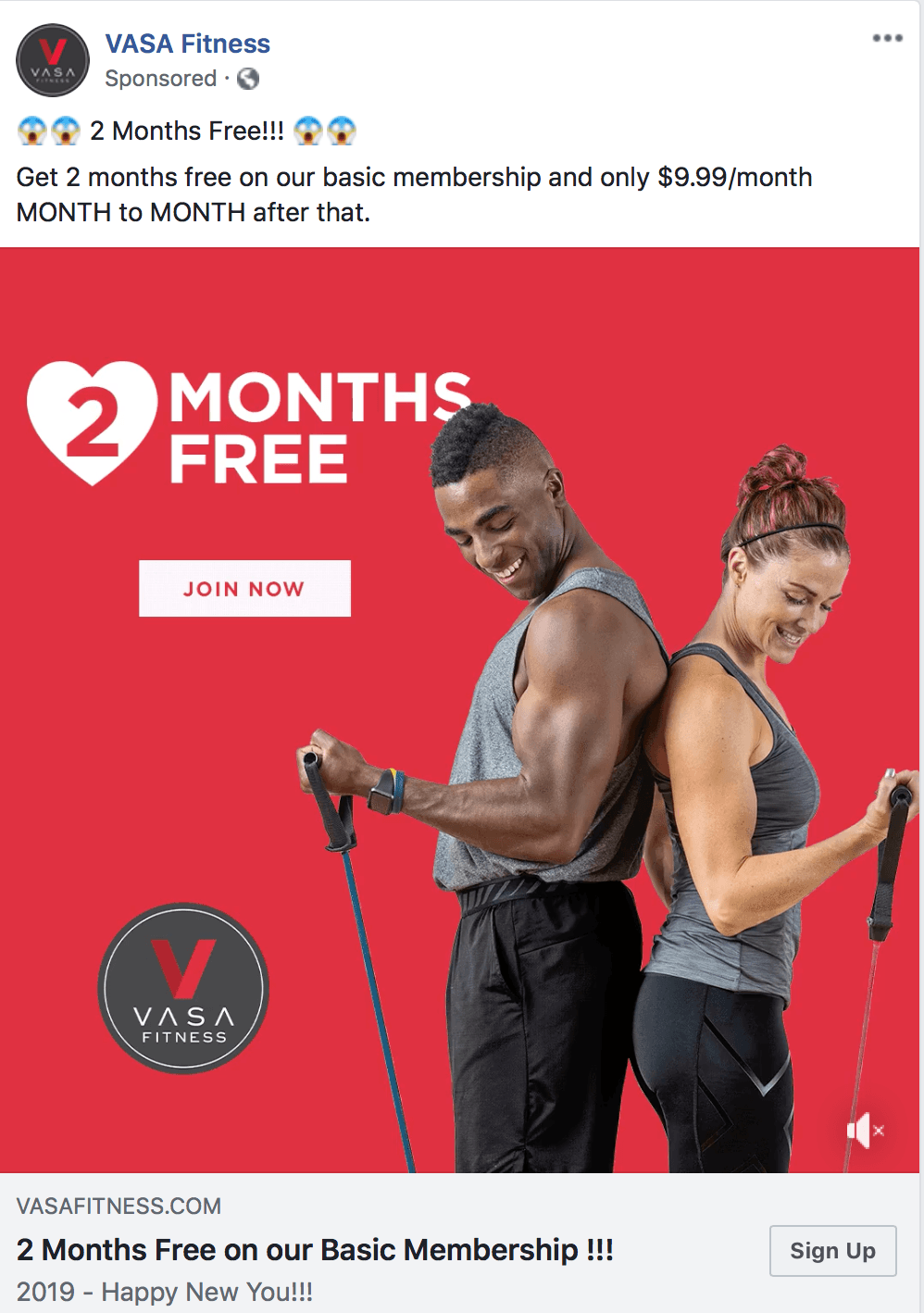
As you look, they used bright ad color, lots of exclamation marks, energetic tone of voice, fun emojis and positive imaging. One can almost feel the excitement to jump into the gym and join!
As you decide to use the excitement tactic in your Facebook ads, make sure it is consistent along the whole customer buying experience. An article in the Wall Street Journal suggests that it takes 20 minutes for the feeling of excitement to pass so you want to keep the momentum going in your buying experience!
It’s best to keep your ad’s landing page as straightforward and exciting as humanly possible to lead people into your intended action! In other words, keep the party going right up until they click “buy.”
How to Use Excitement in Facebook Ads:
- Use Colors to Draw Attention
- Use Ad Images that are Lifestyle and Make People Want to Experience
- Use Ad Offers that Your Audience Would Be Interested In
- Keep Content Short and Use Exclamation Marks
- Include Obvious Discounts
- Use Emojis to Create Visual Feelings
Persuade Per Peers
Unfortunately, most people have been taught to distrust businesses online due to fraud and other problems as of late (ahem, Facebook Breach). So, most marketers tell the story that puts their offer in the best possible light but that is not enough…
You need something that will actually ensure people trust your brand enough to take action.
The best way to do this? Socially proofed Facebook ads.
On Facebook, you want to move beyond Influencers and others who are paid to talk about how awesome your offer is and move towards your current customer base. You have customers and clients who already love your products/services so tap into that resource and use their words in your ad copy!
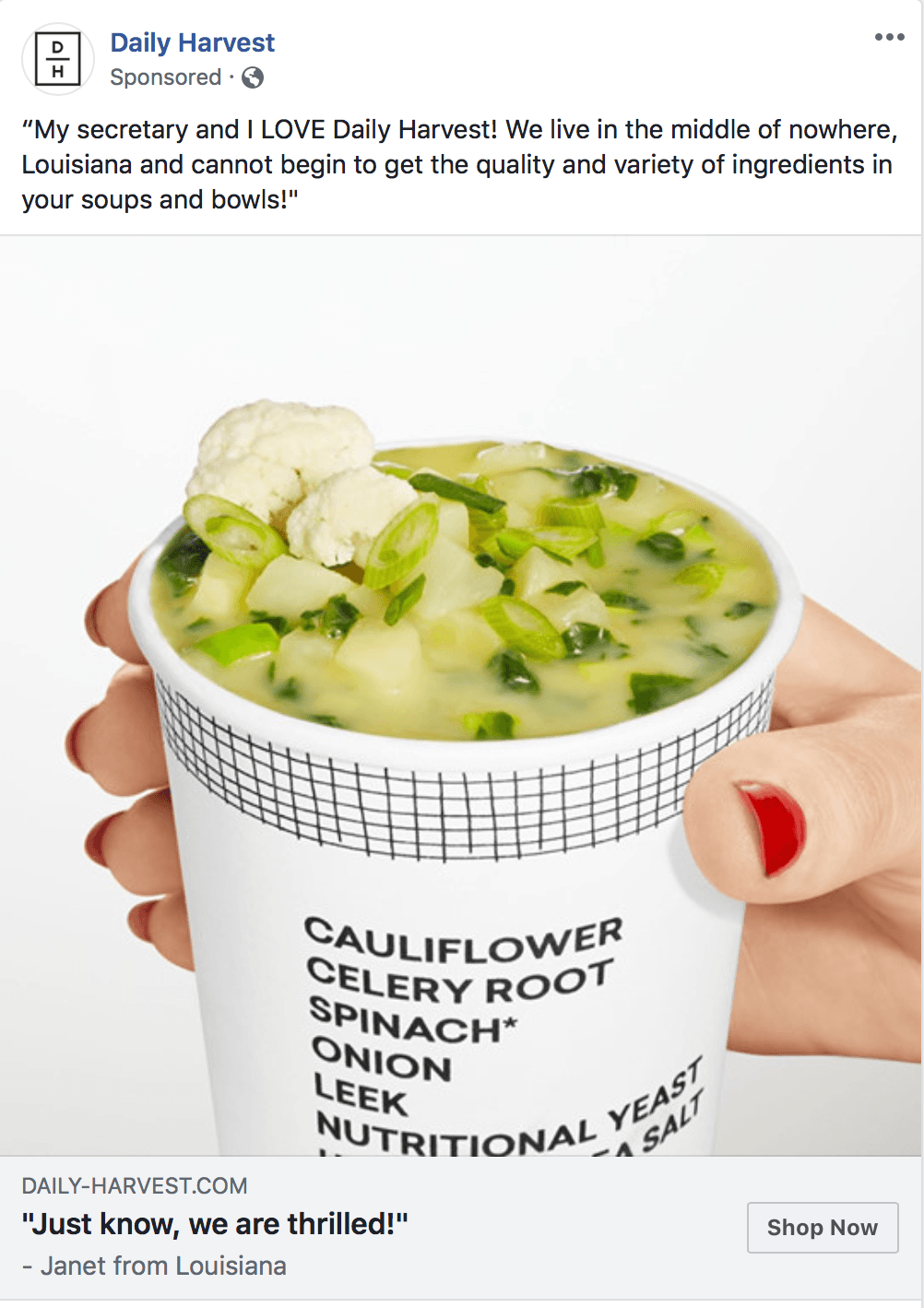
For example, Daily Harvest put a customer’s review in the ad copy of their ad. For anyone looking at this, they can see how their products made THAT customer’s life easier so how could it not work for them? (it’s definitely worth a shot!).
Like them, you can effectively use written, video or visual social proof that will inspire others to buy your products and love your business as much as your current customers do!
How to Use Social Proof in Facebook Ads:
- Add Running Totals of Actions People are Taking Like Downloads, Likes or Use
- Add Customer Testimonials
- Create Testimonial Based Videos and Visual Content
- Show Results of Polls and Surveys
Pique Some Interest
I think we have all read headlines that are irresistible:
10 Ways To Lose 10lbs in a Month…
25 Celebrities That Hate Ellen Degeneres…
Dermatologists Hate Her…
What do all of these articles have it common? They create curiosity within the reader! The curiosity gap tactic in marketing is leveraging the reader’s curiosity to make them click through from an irresistible headline to the actual content. This gap between you and the potential customer can be effectively incorporated into your Facebook ad copy for better results!
For example, Madison Reed sparked interest to potential customers asking the simple question: “Do You Know What’s in Drug Store Hair Color?” As a potential customer who is looking for better hair solutions, this is a question I definitely would want to know the answer to and piqued my interest enough to click their ad link!
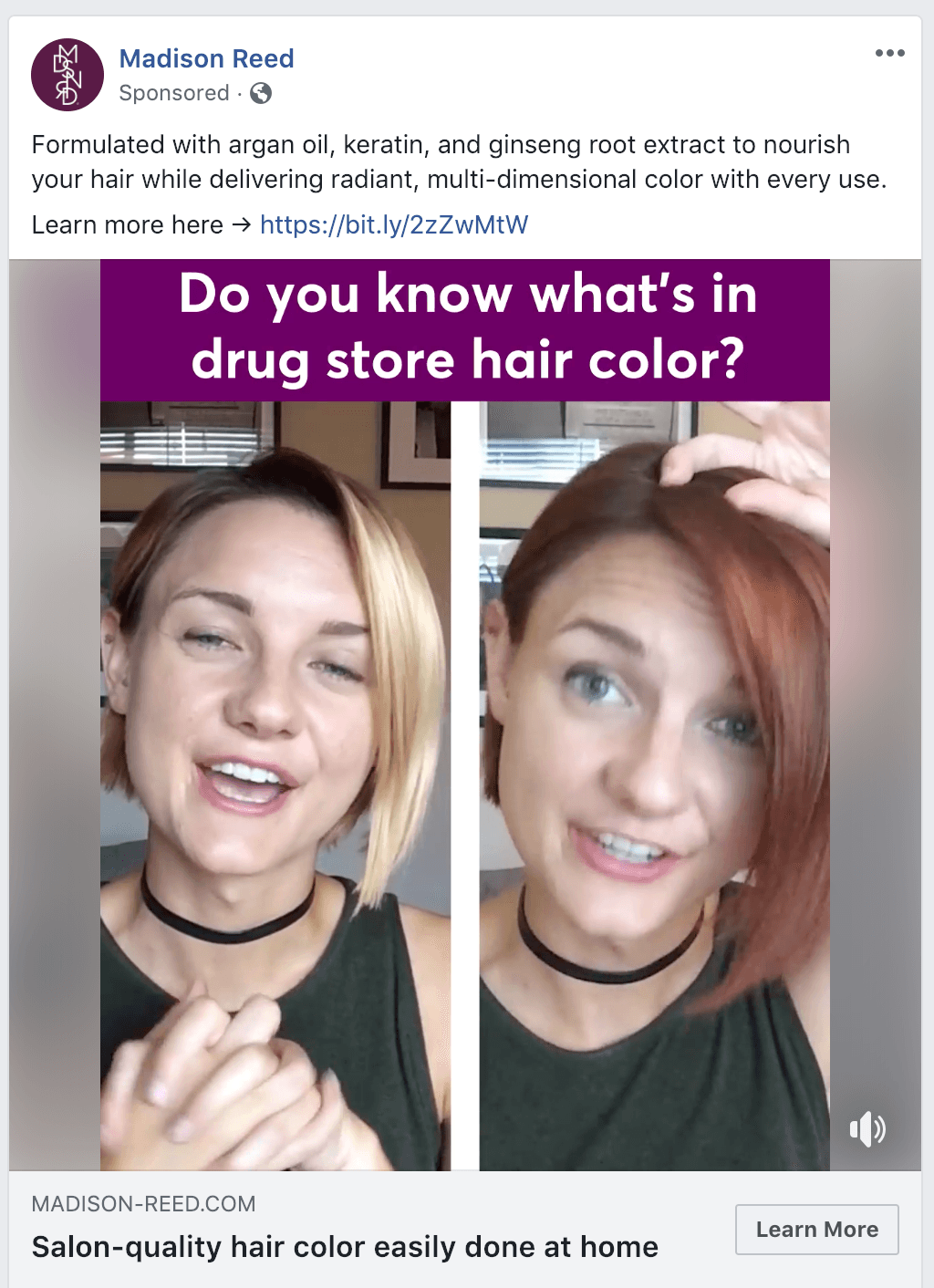
Like this example, the formula for making curiosity work for your Facebook ads is simple:
Ask people a fascinating question and leave the best part untold.
The reason why this works is that people have a natural tendency to connect the dots and discover the answers. It will be hard for them to resist reading and clicking on your Facebook ad after it has asked a fascinating question. Make sure you give answers to cold contacts while others more cultivated can get answers to questions in exchange for information.
How to Use Interest in Facebook Ads:
- Pose Engaging Questions
- Share Interesting Unfinished Stories
- Share an Interesting Statistic
That Wasn’t So Bad, Right? Emotional Marketing
Let’s get real, we all tend to feel emotions whether we like it or not, so weaving that into marketing is a surefire way to get your target audience hooked on your brand as well as inspiring them to take action.
Think of emotional marketing as the secret sauce to Facebook advertising you never knew you had (remember, go for the gut!).
All that is required of you is to do some market research, understand your customers and mostly to evoke emotions needed for them to take action. Align these emotions with your overall marketing goals and you will be golden!
If you need some help is ad copy or want some help shaping your messaging, reach out to me here! I would love to help!
Have you ever been inspired by an advertisement that focused on your emotions? What do you think of emotional marketing? Comment and share below!

